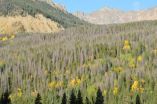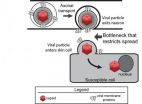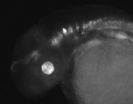(Press-News.org) A new University of Colorado Boulder study shows for the first time that episodes of reduced precipitation in the southern Rocky Mountains, especially during the 2001-02 drought, greatly accelerated development of the mountain pine beetle epidemic.
The study, the first ever to chart the evolution of the current pine beetle epidemic in the southern Rocky Mountains, compared patterns of beetle outbreak in the two primary host species, the ponderosa pine and lodgepole pine, said CU-Boulder doctoral student Teresa Chapman. The current mountain pine beetle outbreak in the southern Rockies -- which range from southern Wyoming through Colorado and into northern New Mexico --is estimated to have impacted nearly 3,000 square miles of forests, said Chapman, lead study author.
While the 2001-02 drought in the West played a key role in pushing the pine beetle outbreak into a true regional epidemic, the outbreak continued to gain ground even after temperature and precipitation levels returned to levels nearer the long-term averages, said Chapman of CU-Boulder's geography department. The beetles continued to decimate lodgepole pine forests by moving into wetter and higher elevations and into less susceptible tree stands -- those with smaller diameter lodgepoles sharing space with other tree species.
"In recent years some researchers have thought the pine beetle outbreak in the southern Rocky Mountains might have started in one place and spread from there," said Chapman. "What we found was that the mountain pine beetle outbreak originated in many locations. The idea that the outbreak spread from multiple places, then coalesced and continued spreading, really highlights the importance of the broad-scale drivers of the pine beetle epidemic like climate and drought."
A paper on the subject was recently published in the journal Ecology. Co-authors on the study include CU-Boulder geography Professor Thomas Veblen and Tania Schoennagel, an adjunct faculty member in the geography department and a research scientist at CU-Boulder's Institute of Arctic and Alpine Research. The National Science Foundation funded the study.
Mountain pine beetles are native insects that have shaped the forests of North America for thousands of years. They range from Canada to Mexico and are found at elevations from sea level to 11,000 feet. The effects of pine beetles are especially evident in recent years on Colorado's Western Slope, including Rocky Mountain National Park, with a particularly severe epidemic occurring in Grand and Routt counties.
Chapman said the most recent mountain pine beetle outbreak began in the 1990s, primarily in scattered groups of lodgepole pine trees living at low elevations in areas of lower annual precipitation. Following the 2001-02 drought, the outbreak was "uncoupled" from the initial weather and landscape conditions, triggering a rise in beetle populations on the Western Slope and propelling the insects over the Continental Divide into the northern Front Range to infect ponderosa pine, Chapman said.
The current pine beetle epidemic in the southern Rocky Mountains was influenced in part by extensive forest fires that ravaged Colorado's Western Slope from roughly 1850 to 1890, said Chapman. Lodgepole pine stands completely burned off by the fires were succeeded by huge swaths of seedling lodgepoles that eventually grew side by side into dense mature stands, making them easier targets for the pine beetles.
"The widespread burning associated with dry years in the 19th century set the stage for the current outbreak by creating vast areas of trees in the size classes most susceptible to beetle attack," said Chapman.
Veblen said a 1980s outbreak of the pine beetle centered in Colorado's Grand County ended when extremely low minimum temperatures were reached in the winters of 1983 and 1984, killing the beetle larvae. But during the current outbreak, minimum temperatures during all seasons have been persistently high since 1996, well above the levels of extreme cold shown to kill beetle larvae in laboratory experiments.
"This implies that under continued warming trends, future outbreaks will not be terminated until they exhaust their food supply -- the pine tree hosts," said Veblen.
Chapman said there has been a massive and unprecedented beetle epidemic in British Columbia, which also began in the early 1990s and has now has affected nearly 70,000 square miles. "It is hard to tell if this current beetle epidemic in the Southern Rockies is unprecedented," she said. "While warm periods in the 16th century may have triggered a large beetle epidemic, any evidence would have been wiped out by the massive fires in the latter part of the 19th century."
Veblen said while the rate of spread of the mountain pine beetle in lodgepole pine forests has declined in the southern Rocky Mountains during the past two years because of a depletion of host pine population, U.S. Forest Service surveys indicate the rate of beetle spread in ponderosa pine forests on the Front Range has increased sharply over the past three years. "The current study suggests that under the continued warmer climate, the spread of the beetle in ponderosa pines is likely to grow until that food source also is depleted," Veblen said.
"Our results emphasize the importance of considering different patterns in the population dynamics of mountain pine beetles for different host species, even under similar regional-scale weather variations," said Chapman. "Given the current outbreak of mountain pine beetles on the Front Range, their impact on ponderosa pines is certainly something that needs further study."
A 2012 study by CU-Boulder Professor Jeffry Mitton and graduate student Scott Ferrenberg showed some Colorado pine beetles, which had been known to produce only one generation of tree-killing offspring annually, are producing two generations per year due to rising temperatures and a longer annual warm season. Because of the extra annual generation of beetles, there could be up to 60 times as many beetles attacking trees in any given year, according to the study.
In addition, a 2011 study led by CU-Boulder graduate student Evan Pugh indicated the infestation of trees by mountain pine beetles in the high country across the West could potentially trigger earlier snowmelt and increase water yields from snowpack that accumulates beneath affected trees.
INFORMATION:
2001-2002 drought helped propel mountain pine beetle epidemic, says CU study
Beetles then moved into wetter and higher elevations
2012-11-05
ELSE PRESS RELEASES FROM THIS DATE:
Spinal cord injury puts patients at high risk of life-threatening cardiovascular events
2012-11-05
New Rochelle, NY, November 5, 2012—Spinal cord injury (SCI) can disrupt the body's sensitive signaling mechanisms that control blood pressure, breathing, and oxygen delivery to the heart and other organs during changes in body position. Cardiovascular (CV) disease is a leading cause of illness and death following SCI, and changes in baroreflex sensitivity—the body's ability to detect and respond to changes in blood pressure—may be predictive of a CV event. A comprehensive review article on baroreflex sensitivity after SCI is published in Journal of Neurotrauma, a peer-reviewed ...
Etiologic diagnosis of nonsyndromic genetic hearing loss in adult vs pediatric populations
2012-11-05
Alexandria, VA — Genetic testing for a certain mutation in pediatric patients is valuable in determining a cause for unexplained hearing loss, according to a study in the November 2012 issue of Otolaryngology–Head and Neck Surgery.
The study's authors state that testing for some of the most common mutations that cause sensorineural hearing loss in a targeted way, rather than through generalized screening of hearing loss patients, yields the best results.
University of Miami NIH-funded researchers led by Dr. Xue Zhong Liu, a physician-scientist, conducted a nine-year ...
The knowing nose: Chemosignals communicate human emotions
2012-11-05
Many animal species transmit information via chemical signals, but the extent to which these chemosignals play a role in human communication is unclear. In a new study published in Psychological Science, a journal of the Association for Psychological Science, researcher Gün Semin and colleagues from Utrecht University in the Netherlands investigate whether we humans might actually be able to communicate our emotional states to each other through chemical signals.
Existing research suggests that emotional expressions are multi-taskers, serving more than one function. Fear ...
Study supports move toward common math standards
2012-11-05
EAST LANSING, Mich. — A new study analyzing the previous math standards of each state provides strong support for adoption of common standards, which U.S. students desperately need to keep pace with their counterparts around the globe, a Michigan State University scholar argues.
Forty-six states are implementing the Common Core math and reading standards, which nonetheless have come under fire recently by some researchers and would-be politicians.
But William Schmidt, MSU Distinguished Professor of statistics and education, said the Common Core is a world-class set ...
Waste management -- good marketing
2012-11-05
This press release is available in Spanish.
Spanish legislation on waste management changed in July last year. Until then, the consumer was responsible for the disposal of products. According to Mr Unai Tamayo, economist at the University of the Basque Country (UPV/EHU), the new laws "foment the construction of closed systems, such as in taverns: the container being taken out and subsequently returned. Moreover, when a manufacturer launches a product on to the market, once consumed, the packaging is considered waste, and the responsibility for this now falls on the manufacturer ...
Princeton researchers identify unexpected bottleneck in the spread of herpes simplex virus
2012-11-05
VIDEO:
Princeton University research suggests that a common strain of herpes virus causes cold sores with only one or two viral particles, resulting in a bottleneck in which the infection is...
Click here for more information.
New research suggests that just one or two individual herpes virus particles attack a skin cell in the first stage of an outbreak, resulting in a bottleneck in which the infection may be vulnerable to medical treatment.
Unlike most viruses that ...
New research suggests standardized booster seat laws could save lives of children
2012-11-05
Boston, Mass, Nov. 5, 2012— A new study by researchers in Boston Children's Hospital's Division of Emergency Medicine indicates that a nationwide standard on booster seat laws for children 4 feet 9 inches and shorter, or up to 8 years old, would save lives. The findings were published online Nov. 5, 2012, in the journal Pediatrics.
Boston Children's researchers reviewed data from Fatality Analytic Reporting System, analyzing child deaths in motor vehicle accidents, looking specifically at whether the crash and resulting deaths or injuries took place in a state with or ...
Computers 'taught' to ID regulating gene sequences
2012-11-05
Johns Hopkins researchers have succeeded in teaching computers how to identify commonalities in DNA sequences known to regulate gene activity, and to then use those commonalities to predict other regulatory regions throughout the genome. The tool is expected to help scientists better understand disease risk and cell development.
The work was reported in two recent papers in Genome Research, published online on July 3 and Sept. 27.
"Our goal is to understand how regulatory information is encrypted and to learn which sequence variations contribute to medical risks," says ...
Superstorm animation
2012-11-05
A computer animation produced by University of Delaware researchers shows the explosive development of Hurricane Sandy, the superstorm and its unusual track. View the animation on the University's UDaily website at http://www.udel.edu/udaily/2013/nov/animation110212.html
Matt Shatley, computer research specialist in UD's College of Earth, Ocean, and Environment (CEOE), assembled the animation by digitally stitching together about 800 infrared images taken by GOES, the Geostationary Operational Environmental Satellite, which keeps a continuous eye on the continental United ...
Japanese family members less likely than others to give CPR for cardiac arrest
2012-11-05
Family members didn't give CPR for cardiac arrests as often as passers-by or friends in a Japanese study presented at the American Heart Association's Scientific Sessions 2012.
Cardiac arrest is the sudden loss of heart function, typically resulting from an abnormal heart rhythm that causes the heart to quiver erratically and stop pumping blood. According to the American Heart Association, effective bystander CPR provided immediately after sudden cardiac arrest can double or triple a victim's chance of survival.
In a review of 547,218 cardiac arrests occurring in 2005-09, ...
LAST 30 PRESS RELEASES:
Archaeologists use AI to create prehistoric video game
Mitochondria migrate toward the cell membrane in response to high glucose levels
Tiny viral switch offers hope against drug-resistant bacteria
Most parents aware of early peanut introduction guidelines, but confused about details
HPV vaccine can protect against severe lesions of the vulva and vagina
Virtual care provision and emergency department use among children and youth
Quadrivalent HPV vaccine and high-grade vulvovaginal lesions
Insights into dry eyes gained from stem cell-derived tear glands
Researchers identify 166 human pluripotent stem cell lines available for use in clinical applications
Europa Clipper instrument uniquely observed interstellar comet 3I/ATLAS
UN University Report challenges climate change as sole trigger of Syrian Civil War, exposing governance failures in drought response
Real estate investment trust (REIT) acquisition associated with hospital closure and bankruptcy
New Raman imaging system detects subtle tumor signals
Boston Children’s receives a $7.5 million grant from Aligning Research to Impact Autism (ARIA) to provide clinical research coordination for the IMPACT Network
Spray-on antibacterial coating offers new protection for plants against disease and drought
ESMT Berlin study: What makes a first offer successful in negotiations
Groundbreaking ceremony marks the beginning of CTAO-South Array construction in Chile
Why swearing makes you stronger
What prevents more cancer patients from enrolling in potentially life-saving clinical trials?
UK’s worst-case climate risks laid bare for lawmakers
A decline in churchgoing linked to more deaths of despair
TAMEST announces Maralice Conacci-Sorrell, Ph.D., UT Southwestern Medical Center, as 2026 Mary Beth Maddox Award & Lectureship Recipient
Global study to evaluate whether dengue outbreaks can be anticipated earlier
Chonnam National University researchers propose innovative voltage-loop control for power factor correction
Accelerating next-generation drug discovery with click-based construction of PROTACs
Detecting the hidden magnetism of altermagnets
$7M gift supports health research, engineering and athletics at UT San Antonio
NU-9 halts Alzheimer’s disease in animal model before symptoms begin
Hospitals acquired by real estate investment trusts associated with greater risk of bankruptcy, closure
City of Hope scientists study rare disorder to uncover mechanism and hormone regulation underlying fatty liver disease and sweet aversion
[Press-News.org] 2001-2002 drought helped propel mountain pine beetle epidemic, says CU studyBeetles then moved into wetter and higher elevations





